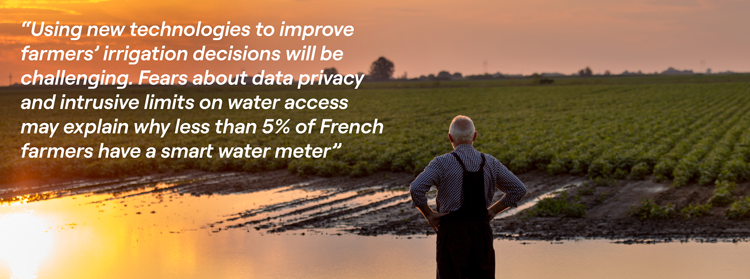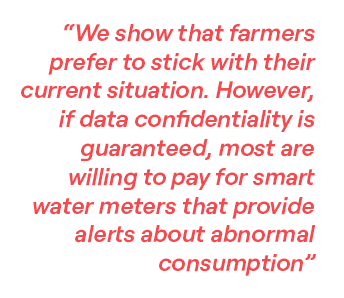Water scarcity is an existential threat for many societies as climate and population pressures intensify conflicts over natural resources. Current projections indicate that half of the world’s population could soon be living in areas without enough water, forcing 700 million people to migrate by 2030. Leader of the Utilities program for TSE Infrastructure and Network Center, Arnaud Reynaud studies how policymakers can promote sustainable management of precious reserves, especially in agriculture which is responsible for 70% of freshwater consumption. Using a national sample of 1,272 farmers, his recent paper investigates how to foster their adoption of smart water meters.
What kinds of policy tools are used to encourage farmers to conserve water?
Signaling scarcity with high water prices is a common policy, but often faces political obstacles. Efforts to develop new water resources tend to be held back by prohibitive costs. Water-sharing agreements have also been proposed, but it is very challenging to ensure farmers adhere to commitments. Farmers have also been encouraged to adopt water-efficient practices such as planting drought-tolerant crops, deficit irrigation, and new technologies including drip irrigation and smart water meters.
What are smart water meters? Do they work?
These connected devices can store and transmit water consumption data at high frequency. They are usually connected to an online platform allowing easy access to the collected data. The smart meters we consider record information on water consumption, in quasi real time, and enable two-way communication between the meter and a central system.
Smart meters allow for improved management of resources, optimizing water releases and restrictions in times of flooding and drought. Their data can be used to implement new water policies such as pricing strategies and water-use reduction targets. For farmers, smart meters may also provide new services such as early warning of leakages, high consumption, and other unusual events. Equity and collective action can also be improved with more accurate information, making it easier for farmers to pay according to their real consumption.

Evidence on the ability of smart water meters to improve water management remains limited. A 2017 study in Oman suggests there may be significant gains in groundwater management. However, my 2019 study with my TSE colleague Sylvain Chabé-Ferret suggests that using new technologies to improve farmers’ irrigation decisions will be challenging. Fears about data privacy and intrusive limits on water access may explain why less than 5% of French farmers currently have a smart water meter.
How does your study investigate ways to overcome farmers’ reluctance?
Our study aims to assess how farmers value various characteristics of smart water meters and to test different policies for boosting their adoption. Most research on the use of incentives to foster sustainable practices focuses on either monetary or non-monetary policy tools. In contrast, we assess the joint effect of a conditional subsidy with two types of informational nudges. We combine a discrete choice experiment – a state-of-the-art method to elicit preferences for hypothetical alternatives – with randomized treatments.
Farmers were surveyed about a subsidy that is paid only if the local adoption rate reaches a given threshold (25%, 50% and 75%). This policy aims to reinforce a collective dynamic for two reasons. First, adoption by many farmers is crucial for the technology to be effective. Second, farmers may be more likely to take part if they believe their neighbors are doing the same.
To increase its efficiency, our first nudge is a ‘cocktail’ of three types of nudges (reminder, priming and commitment). It reminds respondents about water restrictions, asks them about the importance of better water management and their willingness to commit to it, and informs them about the benefits of smart meters.
Our second nudge informs farmers about their peers’ behavior using the testimony of Yves, a 59-year-old farmer who recounts his positive experience in reducing water losses (and costs) by using a smart meter. Empirical evidence in psychology suggests that people are more likely to follow a social norm if they identify with the individual or group of reference.
How can this research encourage sustainable water use?
Our study sheds light on the power of public policies to promote sustainable choices by changing ideas about social norms. We investigate the effects and potential applications of incentive policies and suggest that governments should target information campaigns to increase farmers’ awareness about the benefits of smart meters. Our key results are as follows:
 First, we show that farmers prefer to stick with their current situation, whether they have a mechanical meter or no meter. However, if data confidentiality is guaranteed, most are willing to pay for smart water meters that provide alerts about abnormal consumption.
First, we show that farmers prefer to stick with their current situation, whether they have a mechanical meter or no meter. However, if data confidentiality is guaranteed, most are willing to pay for smart water meters that provide alerts about abnormal consumption.
Second, the combination of the subsidy and the nudges encourages farmers to adopt a smart meter. However, additional analysis suggests we need to interpret the nudge results with caution. While it confirms the effect of our ‘cocktail’ nudge, we no longer detect any significant effect of the ‘testimony’ nudge. This indicates that nudge policies need to be carefully tested and designed.
Third, the effect of the subsidy does not rely much on the required participation threshold. Surprisingly, farmers are not discouraged even by a high collective threshold of 75%. This finding may be useful for designing cost-effective policies. It suggests that a high threshold can be used to reduce costs – since it has a lower probability of being reached – without discouraging smart meter use.
FURTHER READING ‘Nudging and subsidising farmers to foster smart water meter adoption’ is coauthored by Benjamin Ouvrard, Raphaële Préget and Laetitia Tuffery. Related publications by Arnaud, including ‘Can we nudge farmers into saving water?’ (2019), are available to view on the TSE website.
Article published in TSE Reflect, May 2024




